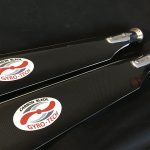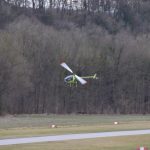The Institute of Aviation once again proved its competence in the field of services for the aviation industry. As part of the completed research project of the Gyro-Tech Innovation in Aviation Sp. z o.o., realized in cooperation with the Institute of Aviation, innovative helicopter rotors were developed. The tests showed their global quality and the highest competitiveness in relation to the products currently used on the market.
As part of joint work in the “Innovative composite rotors for ultra-light helicopters” project, two types of rotors were designed, including one with an innovative profile developed at the Institute of Aviation, dedicated specifically to the rotors of light helicopters. All the necessary analyzes required for their admission to the flight were carried out, followed by functional tests on the ground and in the air.
As a result of the cooperation, Gyro-Tech, a world-renowned manufacturer of gyrocopter rotors, has expanded the range of production into rotor blades for light and ultra-light helicopters.
Today we can talk about the success of the project because the blades have been successfully tested on several different constructions and have already found their recipients in the world.
With very positive opinions of pilots, blades developed at the Institute of Aviation are used on such helicopters as: Dynali H3, CH7 Kompress, Cicare 8, and on the popular Robinson R-22.
The project manager was Tomasz Szczepanik from the Center of Transportation and Energy Conversion of the Institute of Aviation. The project was co-financed from the Intelligent Development Operational Program aimed at supporting industrial R&D of small enterprises. The project was carried out from January 2016 to December 2018.
Video materials from tests:
Tests of both the rotor and tail rotor developed independently by Gyro-Tech for the Italian Kompress CH7 helicopter, operated by the user in Austria. The tests showed a marked reduction in the vibration of the double-blade rotor, which in this regard approached the operating level of three-blade rotors. The blades also have lower resistances thanks to which easier control of the tail rotor is achieved, as well as a clear increase in speed achieved by almost 20 km/h.
Flight tests with the Argentine helicopter manufacturer Cicaré Helicópteros S.A. At the controls of the Cicare-8 machine sat the company owner, Fernando Cicaré and 81-year-old Augusto Cicaré, who founded the company 60 years ago. The tests included about 5 hours of flight during which the behavior of the helicopter with new blades was tested, confirming correct behavior and low vibration in all flight phases, including autorotation and full speed range.
Last year’s final tests in December 2018 in Viareggio, Italy. Mauro Antogiovanni was the pilot. The tests were carried out on the very well-known American Robinson R-22 helicopter, which is not really ultra-light, but the Gyro-Tech blades are also suitable for it. The tests confirmed the high quality of the blades, thanks to which the helicopter could obtain in flight a speed higher by approx. 10 km/h, and at the same time a fall rate of about 10% lower by autorotation. The new rotor also generates significantly lower noise, and thanks to higher inertia than in original blades, i.e. after engine failure, it allows to maintain the rotor energy for up to 4 seconds, comparing with original blades only 1 second.
All photos and videos were made by Gyro-Tech employees.
More about the project:
The subject of the “Innovative composite rotors for ultra-light helicopters” project was to carry out industrial research and development work aimed at mastering complex technological process of creating rotors for rotorcrafts, and in particular, for helicopters, and subsequently, to develop on its basis commercial trade products.
This activity is a response to the clear market demand from foreign customers, as part of the global trend of replacement of rotors in helicopters, from traditional duralumin or mixed dural-composite to modern, completely composite solutions, improving the performance of the structure and extending the service life. The general idea was to combine the strength of two national industry leaders: Gyro-Tech, which has the country’s largest manufacturing experience in the production of autorotative rotors, and the leader in the field of industry research and development in aviation, which is the Institute of Aviation.
To achieve the project’s objectives, computational analyzes in the field of aerodynamics, CFD and flight mechanics, strength of MES materials, material tests of composites, technological tests of the latest available fiber reinforcements of polymer composites, strength tests of root parts and nodes were carried out.
Rotors made as physical objects were subjected to ground-based testing on dedicated test stands and underwent functional tests in the air.














